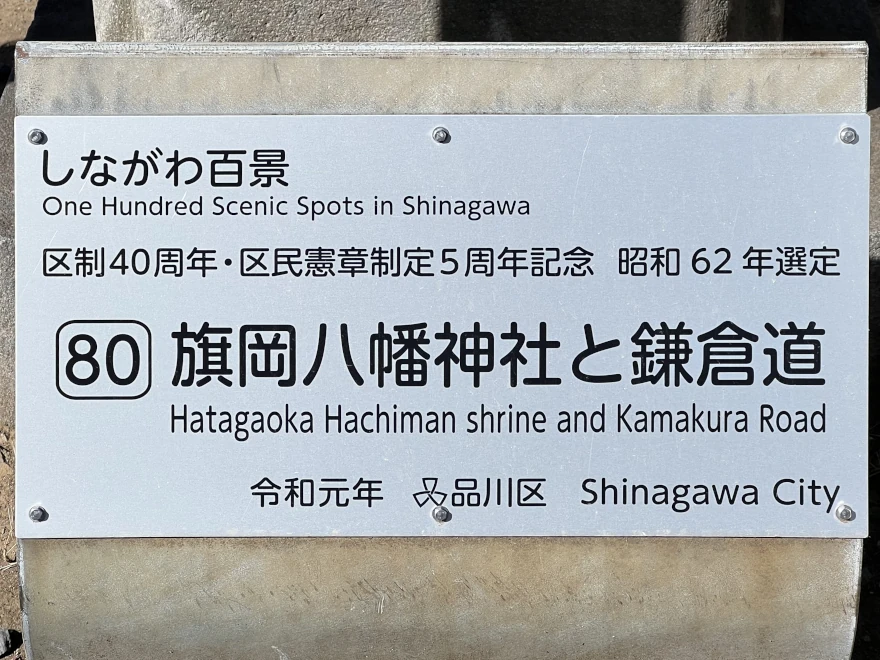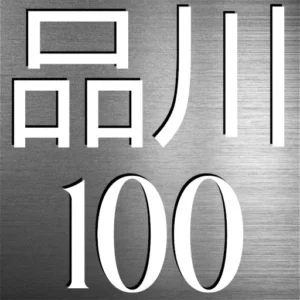⛩️ Hatagaoka Hachiman Shrine – Origins of Hatanodai’s Name
📜 Legendary Origins and the Genji Connection
Hatagaoka Hachiman Shrine (旗岡八幡神社) stands on a gentle rise in Shinagawa’s Hatanodai district, a location steeped in Genji lore. Its origins trace back to 1030 CE (Chōgen 3), when Minamoto no Yoriyoshi (源頼義) (sometimes identified in some versions as Minamoto no Yorimitsu (源頼光) or Yorimasa (頼政)) camped here en route to suppress the revolt of Taira no Tadatsune (平忠常) in present-day Chiba. According to shrine tradition, he experienced a divine presence and enshrined the deity Hachiman here to pray for military victory.
🏞️ The Name and the Land
The shrine takes its name from this historic act — “Hatagaoka” (literally, “flag hill”) and the broader area’s name “Hatanodai” recall the white Genji banners (白幡) fluttering across the battlefield. The site’s long association with the Minamoto clan and local lords helped cement its role as a spiritual and cultural anchor for the district.
🛤️ Along the Kamakura Road
Importantly, the shrine is situated along one of the old Kamakura Roads (鎌倉道) — a medieval highway system that linked Kamakura with other parts of Japan. This route would have been a natural path for Yoriyoshi’s eastward campaign, and its historical role as a connector of eastern provinces further underlines the shrine’s strategic and symbolic location.
🏯 Medieval and Edo Revival
In the mid-Kamakura period, local lord Ebara Saemon-no-jō Yoshimune (荏原左衛門尉義宗) rebuilt the shrine and entrusted its stewardship to his son Tokujirō, who became the monk Rōkei Shōnin (朗慶上人). He also founded the neighboring Hōrenji Temple (法蓮寺), which served as the shrine’s bettō (caretaker temple). The intertwined history of shrine and temple endured through Edo times, with powerful Tokugawa patrons supporting its upkeep.
🏛️ Architecture and Cultural Significance
The current shrine structures were rebuilt in 1964 and renovated in 2014. The Ema Hall (絵馬堂), which survived WWII air raids, is now a Registered Tangible Cultural Property of Japan. The shrine’s grounds feature plaques and displays detailing its storied past.
🌀 Shrine Details
- Enshrined Deities: Hondawake-no-Mikoto (Emperor Ōjin), Hime-Ōkami, Okinagatarashi-hime-no-Mikoto (Empress Jingū)
- Founded: 1030 CE by Minamoto no Yoriyoshi
- Annual Festivals: Reitaisai in early September; the famous 甘酒祭り (Sweet Sake Festival) held on February 15
- Historic Names: Formerly known as Nakanobu Hachiman
- Notable Treasures: A votive ema painting of a monkey pulling a horse (猿駒止の絵馬), designated a cultural property by Shinagawa Ward — and the Ema Hall itself is a nationally registered Tangible Cultural Property.
🧭 Visitor Information
Address: 3-8-52 Hatanodai, Shinagawa-ku, Tokyo 142-0064
Best season: Early September (Reitaisai), mid-February (Sweet Sake Festival)
Admission: Free
Official Info: https://hatagaokahachiman-jinja.jp
Note: Ema Hall is a highlight. Barrier-free paths available.
Where is it?
| what3words | ///activism.paddle.roaring |
| latitude longitude | 35.60471, 139.70854 |
| Nearest station(s) | Ebara Machi Station (Oimachi Line) |
| Nearest public conveniences | Inside the next door Horenji temple, the station or nearby convenience stores |
Show me a sign.

The Hyakkei sign is located at the top of the steps at the east entrance in front of the guardian lion-dog.
💬 Withervee says…
When I visited Hatagaoka Hachiman Shrine, it was incredibly quiet—just the sound of the wind rustling through the trees and a few visitors paying their respects. There were no crowds or grand gates, but that calm is exactly what gives the place its presence. It’s clear the shrine still means a lot to the local community, even if it doesn’t make top tourist lists. During major events like the Reitaisai or the Sweet Sake Festival, it springs to life with lanterns, stalls, and neighborhood pride.
Online reviews echo this sentiment. Visitors describe the shrine as “peaceful,” “authentic,” and “steeped in history.” Families come for traditional rites, and locals know this hilltop shrine as a spiritual anchor.
Among the key features on site are:
- Honden (main hall)
- Haiden (worship hall, rebuilt in 1964)
- Ema-den (絵馬殿) – surviving WWII air raids, now a Registered Tangible Cultural Property
- Kaguraden (dance hall for sacred performances)
- Torii gate and stone lanterns
- Hōrenji Temple (法蓮寺) next door, the former bettō (caretaker temple)
This is a shrine that rewards quiet attention. Whether you’re visiting during a major festival or just taking a reflective stroll down the Kamakura Road, Hatagaoka Hachiman offers a glimpse of Tokyo’s layered past—alive and well in the present.
Site Character
- Historical Significance 歴史 (Rekishi): ✔️
- Atmosphere/Natural Features 風土 (Fūdo): ✔️
- Lifestyle 生活 (Seikatsu): ✔️
- Spiritual Significance 霊性 (Reisei): ✔️
- Hidden Gem 隠れ家 (Kakurega): ✔️
Who in their right mind would vote for this?
- Local (Shinto) worshippers
- History nerds
- Shrine photographers
- Students of Edo culture
- People who like monkeys and sacred arrows
Further reading
Hatagaouka Hachiman Shrine – Wikipedia (Japanese)
Kamakura Roads – Wikipedia (Japanese)
While you’re there…
Horenji temple is right next door.
Previous
79: Togoshi Ginza

